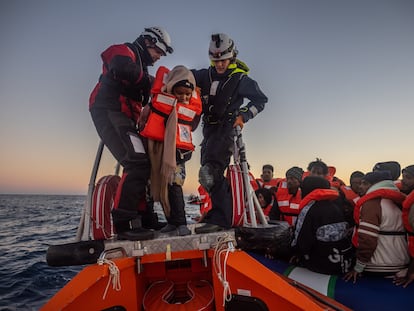Migrant deaths and irregular arrivals reached a new high in the EU in 2023
The International Organization for Migration warns of a humanitarian emergency due to the significant amount of victims; at least 3,863 people lost their lives last year trying to cross a European border

For the European Union, 2023 was the year of shielding. Borders were sealed tighter and policies were approved to facilitate the deportation of those who managed to get around Europe’s efforts to curb the irregular entry of migrants. However, these measures have not yet produced the expected results: at least 281,431 people entered clandestinely the EU in the last 12 months, 48% more than the previous year, according to data from the International Organization for Migration (IOM) covering up to December 31.
The main access point was Italy, with 57% of all arrivals. At least 3,863 people died while attempting to cross a European border, according to the same organization, which relies on testimonies from survivors and relatives to make its calculations.
The final figure for 2023 is the highest recorded since the 2015 crisis, although it does not come close, since that year more than a million people entered irregularly in what was the largest human displacement into European territory since World War II. Flavio Di Giacomo, spokesperson for the IOM Mediterranean Coordination Office, does not consider the current situation a migration emergency, as certain European media and politicians have warned. “Even in Italy the increase is not worrying, because we have seen these numbers in the past and they were not considered an emergency. They represent 0.26% of the Italian population and 0.03% of the EU population,” he contextualizes. “It is a very Eurocentric vision, because 85% of African migration occurs within Africa itself,” he adds.
The EU grants approximately three million different stay permits annually, so the undocumented migrants only represent around 8% of the foreigners who arrive each year.
To this number of non-EU citizens, we must also add the 4.3 million beneficiaries of temporary protection who fled Ukraine after the beginning of Russia’s invasion in 2022. “When the war started, six million Ukrainians arrived in three months, and no one referred to that as an immigration emergency. On the contrary, Europe’s response was quite efficient,” recalls Di Giacomo.
Most arrivals to the EU come from the sea, mainly the Mediterranean, on all its fronts: western, towards the Iberian Peninsula; eastern, towards Greece, and central, towards Italy. 252,942 people managed to reach European coasts after dangerous journeys in metal or wooden boats. The remaining 28,489 entered by land.
One of the last to join the new arrivals was Hamza. Originally from Daraa, where the Syrian revolution started, this 25-year-old sociology graduate entrusted €4,500 (almost $5,000) to a Libyan trafficker so he could get on a barge. In the early hours of December 29, he sent a message to a relative in Spain to inform him that he had been taken to a beach with a hundred other people, and that this time it seemed that he was indeed boarding.
The next day, his relative contacted different NGOs dedicated to rescue at sea, but no one was near the area where the ship could supposedly pass; they were very far away, out of service or transporting other rescued people. “The only chance they have is that the sea is going to be fine tonight,” remarked an experienced NGO captain who was off duty. After more than 24 hours without coverage, Hamza sent a message to his relative: “Hello dear, how are you? I arrived in Lampedusa [Italy] at 12 at night, thank Allah.”
Hamza’s case was not exceptional: in 2023, Italy was the country in the region that received the most irregular migrants — despite the promises of the far-right Prime Minister Giorgia Meloni to curb the entries — receiving at least 157,652 people, 50% more than the last year and 57% of all EU arrivals. Most of them came from Tunisia, which for the first time replaced Libya as the busiest route, despite the signing last July of an agreement of understanding between the European Commission and President Kais Saied.
Spain was the second European country in which arrivals increased the most in 2023, as well as the second with the greatest increase compared to the previous year. Meanwhile, Greece was the third EU country with the most arrivals (48,563), but the one with the highest percentage increase: 145% more, almost three times those of the previous year. Of the new arrivals, the vast majority (almost 42,000) arrived in precarious boats from the coasts of Turkey to the islands of Lesbos, Samos, Kos and Rhodes, mainly. Another 7,000 migrants entered the country by land, a similar number to previous years.
Europe, the world’s largest cemetery
Crossing a European border without papers is not easy: 3,863 people died or disappeared trying, another record number, bringing the estimated total of dead or missing people since 2014 to 28,000 (when IOM records began). Today, Europe has become the deadliest place on the planet for those who try to enter clandestinely.
The Mediterranean continues to be the largest maritime cemetery in the world: 2,797 people remain under its waters, 72% of those lost this year, and more than 28,000 of the victims registered in the last decade. “While it is not correct to speak of a migration emergency, it is correct to speak of a humanitarian emergency,” says Di Giacomo. The expert speculates that the actual death toll is much higher, but many go unrecorded due to the difficulty of documenting shipwrecks and the fact that most bodies are never found. However, the NGO Caminando Fronteras uses less conservative figures, raising the number of dead or missing to 6,618 only on the access routes to Spain, mainly to the Canary Islands (6,007), while the IOM puts that journey’s death toll at 914. And at least 152 more have been recorded in other European borders, such as the English Channel, the Western Balkans or that of Belarus with the EU.
Although most deaths occur on the route between Tunisia and Libya towards Italy, the most serious event took place in Greek waters, in the Ionian Sea. It was the shipwreck of the ship Adriana, which set sail from Libya on June 13, succumbing with all the passengers on board. The official number of victims is 596, mainly women and children. Previously, on February 26, another sinking took place off the coast of Cutro, northeastern Italy, in which at least 94 people drowned.
Alternative routes and sealed borders
The Western Balkan route was less busy in 2023, with 161,592 irregular border crossings, 19% less than in 2022. However, UNHCR, the U.N. Refugee Agency, estimates the number of people stranded in the region at around 8,400.
The eastern flank of the EU is one of the most fortified in the world since the 2021 migration crisis, when Belarusian President Aleksandr Lukashenko was accused of orchestrating the transfer of refugees and migrants to Lithuania, Latvia and Poland in response to EU sanctions. In 2023, Polish border authorities thwarted 26,000 entry attempts; Latvia, 13,000; Lithuania, another 2,500. These three countries have adopted strong restrictive measures, closing their borders, erecting more miles of fences, deploying the military and legalizing pushbacks.
Sign up for our weekly newsletter to get more English-language news coverage from EL PAÍS USA Edition
Tu suscripción se está usando en otro dispositivo
¿Quieres añadir otro usuario a tu suscripción?
Si continúas leyendo en este dispositivo, no se podrá leer en el otro.
FlechaTu suscripción se está usando en otro dispositivo y solo puedes acceder a EL PAÍS desde un dispositivo a la vez.
Si quieres compartir tu cuenta, cambia tu suscripción a la modalidad Premium, así podrás añadir otro usuario. Cada uno accederá con su propia cuenta de email, lo que os permitirá personalizar vuestra experiencia en EL PAÍS.
¿Tienes una suscripción de empresa? Accede aquí para contratar más cuentas.
En el caso de no saber quién está usando tu cuenta, te recomendamos cambiar tu contraseña aquí.
Si decides continuar compartiendo tu cuenta, este mensaje se mostrará en tu dispositivo y en el de la otra persona que está usando tu cuenta de forma indefinida, afectando a tu experiencia de lectura. Puedes consultar aquí los términos y condiciones de la suscripción digital.
More information

Why is there a new surge in migrant boats to Spain’s Canary Islands?
Archived In
Últimas noticias
Welcome to the post-religion era: The idea of Christianity as the absolute truth has become obsolete
‘I thought you would like it’: The risky sexual practice popularized by TV shows and TikTok
The digitalization of tourism: ‘They promise experiences and gave us the worst possible one’
Mexican peso defies uncertainty with forecasts of a new period of stability in 2026
Most viewed
- Sinaloa Cartel war is taking its toll on Los Chapitos
- Reinhard Genzel, Nobel laureate in physics: ‘One-minute videos will never give you the truth’
- Oona Chaplin: ‘I told James Cameron that I was living in a treehouse and starting a permaculture project with a friend’
- Why the price of coffee has skyrocketed: from Brazilian plantations to specialty coffee houses
- Silver prices are going crazy: This is what’s fueling the rally










































